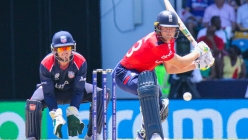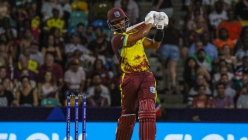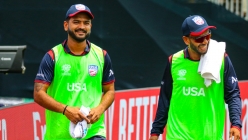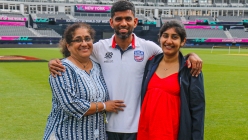Views
USA Cricket: 2019 Super50 Tour Report Card Part 1 – Team Grades
2019 Dec 03 by DreamCricket USA
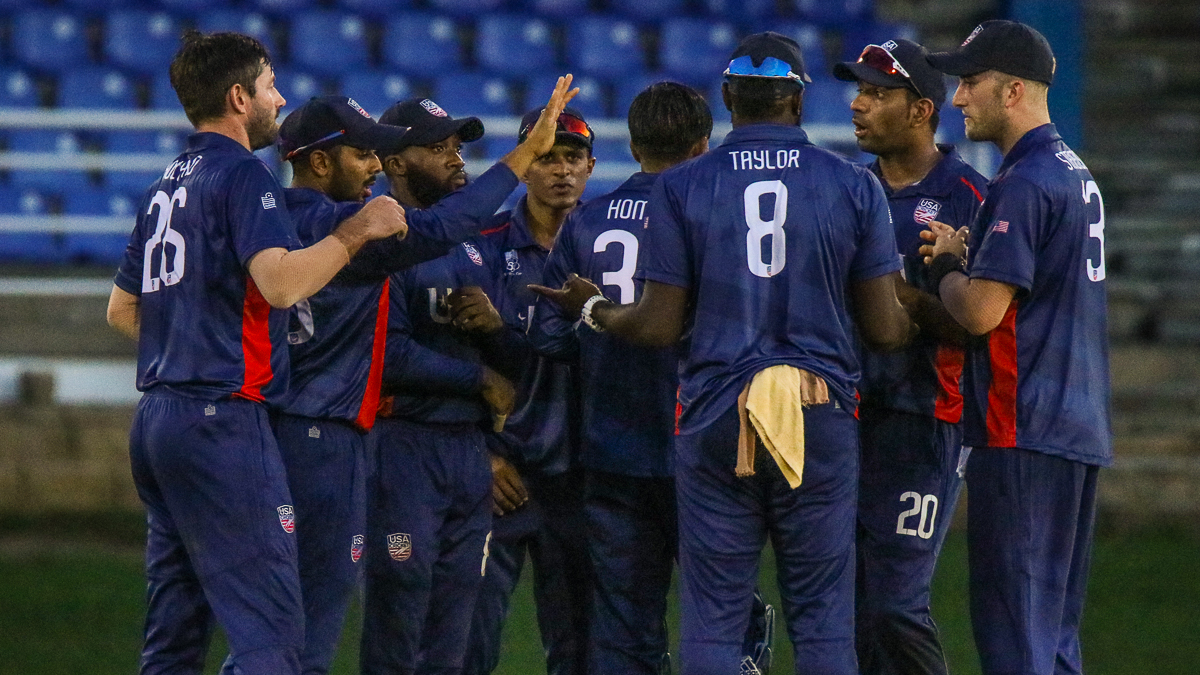
By Peter Della Penna (Twitter @PeterDellaPenna)Photo credit: Peter Della Penna
Part one of DreamCricket's tour report card review of USA's eight-match tour of Trinidad for the 2019 CWI Super50 focuses on each of USA's collective performances in four areas: batting, bowling, fielding and fitness.
Batting: D
The emphasis here is on the “team” batting grade. Individually, only one or two players were really worthy of getting a D grade on the batting side. But the collective approach was poor regardless of the step up in class facing first-class opponents in the West Indies. In particular, the failure to bat successfully in partnerships was highlighted non-stop in the tournament.
USA had four 50-plus partnerships, by far the fewest of any team in the tournament. Seven of the ten teams had a minimum of 10 50-plus partnerships in the tournament. The only other two teams who had fewer than ten were CCC (6) and Canada (7). Unsurprisingly, they finished in the bottom two in their zone. Coincidentally, two of USA’s four half-century partnerships came in one of their two wins (against Guyana).
By contrast, USA had 18 partnerships that crossed 30 but didn’t reach 50. It was symbolic of the individualistic approaches of numerous batsmen who were running hard for themselves when the ball came off their bat, but were static at the non-striker’s end when their partner was looking for runs. It was hard to find a team that was worse at running between the wickets than USA. Consequently their best showing in terms of positive running between the wickets to pinch tight ones and twos came in the final match against Guyana, which they won by eight runs. All the tight twos in particular that they shied away from in their previous losses made a massive difference in this encounter.
One of the biggest problem areas for USA was the Powerplay. They had 66% or more dot balls in six of their eight Powerplays (three of USA’s matches featured Powerplays that were less than 10 overs due to rain delays). At the same time that they could not rotate the strike with singles, there was an overall lack of aggression demonstrated by lack of boundary-scoring and hitting over the top of the infield during the Powerplay. USA scored five boundaries or less in seven of their eight Powerplays.
Part of USA’s Powerplay issues stemmed from the poor opening partnerships. USA trialed four different opening combinations but none of them really produced any magic as a combo. USA’s opening stand averaged 16.38 with a best of 43. On five of eight occasions the stand ended before 20. There will be more on this in subsequent parts of the tour report card as it has become fairly clear that several players are batting out of ideal position.
Ironically, USA’s best Powerplay performance came in a match reduced to 30 overs vs. Trinidad & Tobago when they struck five fours and two sixes off the first 36 balls to reach 50 for 1. By far their worst Powerplay performance came in their third match of the tournament against Windward Islands when they racked up a staggering 51 dot balls and struck three boundaries to crawl to 22 for 1 in 10 overs.
In general, there was an overall lack of aggression that has been a problem for the better part of 2019. USA struck 36 sixes in the tournament, well behind group leader Trinidad & Tobago with 59 and tournament leader Jamaica with 71. The only teams who struck fewer sixes than USA were Canada (28), CCC (27) and Windwards (35). Unsurprisingly, all four of these teams finished in the bottom two of their zones. The disappointing part about it from USA is not that there is a lack of skill but a lack of intent and a lack of situational/match awareness. Most of USA’s opponents were able to recognize and target short boundaries for six options whereas many of USA’s players were caught trying to clear the longest side of the ground instead of similarly targeting short boundaries for six options.
On the individual contribution note, USA had five 50-plus scores from their batsmen. This was the fewest of any team in the tournament. Canada had six such scores of 50-plus from individual batsmen and Windward Islands had seven. Again, both of those teams finished in the bottom two in their zone. USA didn’t have a single player in the top 20 of the top scorers in the event. The best was Monank Patel at 21st overall with 230 runs and nobody else was in the top 30 for USA.
The bottom line is that USA’s bowlers kept them in many games and put USA into numerous winning positions that their batsmen could not capitalize on. On paper, USA winning two out of eight games in the CWI Super50 sounds commendable based on prior precedent, especially since one of those two wins came against the eventual tournament champion West Indies Emerging team. But the reality is that USA could very easily have won two or three more matches had their batsmen not regularly failed to contribute against many teams who were missing first choice West Indies players that were touring India or playing in overseas franchise competitions.
Bowling: B
USA’s bowlers collectively did a commendable job and were really only overmatched on two occasions against Trinidad & Tobago’s aggressive batting unit. There were 18 century partnerships put on by teams in the Super50, but USA’s bowlers only conceded one of them, an unbeaten 100-run stand in seven overs by Jason Mohammed and Odean Smith of Trinidad & Tobago when conditions were extremely difficult to bowl due to a very wet ball.
Otherwise, USA’s bowlers generally did a very good job of getting breakthroughs and applying pressure early on. USA claimed two or more wickets in the Powerplay in five of eight matches, and took three wickets on two occasions. Their worst Powerplay performance was against Windward Islands in the penultimate match when they conceded 66 for 0 in the first ten overs. Otherwise the bowling was generally tight at the front.
USA’s death bowling was mixed but generally above average. They often struggled bowling under lights with a dewy/wet ball but those are not conditions that the majority of USA’s players are exposed to regularly, nor are they the types of conditions that will be a common occurrence in the playing regulations of Cricket World Cup League Two ODIs.
Karima Gore led the team once again on tour with 10 wickets, which was good for 20th overall in the tournament. However, many bowlers were rotated in and out throughout the tournament so the lack of individual brilliance is not as problematic as it was on the batting side. Collectively, there was promise in terms of the depth of options demonstrated and at times it actually backfired with bowlers like Gore not bowling out their full quota of overs because a sixth or seventh bowler was regularly being rotated into or out of the attack.
The only glaring issue from an individual perspective in terms of lack of match-winning contributions for the team is that nobody took four wickets in a match, let alone five. Compared with players on the opposite side like Keron Cottoy and Raymon Reifer who took match-winning five-wicket hauls, it doesn’t take much to figure out that such performances win matches and USA could not get their bowlers to produce a match-winning performance like that.
Fielding: C
USA’s catching and fielding was not noticeably better or worse than many of the teams they came up against. On the tournament, they unofficially missed 14 chances in the field across eight matches (three runouts and 11 drops) that cost them 273 runs, on average a total of 24.81 runs from the time the first chance was missed until the batsman was dismissed (if they were at all). The costliest miss came when Jason Mohammed was spilled on a somewhat awkward return chance spooned back to Ian Holland off a slower ball when Mohammed was on 14 and wound up to score 101 not out off 62 balls.
USA’s opponents by comparison missed 19 chances on USA’s batsmen, which wound up costing them a total of 377 runs. It cost USA’s opponents an average of 29 runs after the first missed chance, if a batsman was dismissed at all. The costliest drops came off Monank Patel, who was spilled at slip on 1 in the final match against Guyana and went on to make 85, Steven Taylor who was dropped on 0 against Windward Islands and made 62, and Xavier Marshall who was dropped on 11 against Windward Islands and made 79. So by that measure, USA’s opponents actually fielded comparatively worse than USA in the catching and runout department.
But the area where USA was really outclassed was in ground fielding. The first/trigger/reaction step made by USA fielders was consistently poor. Opponents regularly stole tight singles and twos off them. There were also constant fumbles and misfields. The worst ground fielding performance arguably came in the seventh match against Windward Islands in which USA lost by 11 runs on a night when their ground fielding was shockingly poor. Had they put in an average performance at the very least, they probably would have won that match.
The collective wicketkeeping from both Monank Patel and Akshay Homraj was also average at best. Although there were not any glaring or outrageous drops that were costly, there were consistent fumbles on regular takes, something that typically does not inspire confidence in bowlers. Based on the early evidence, both have to step up their batting significantly to compensate for their glovework if they are to be picked as keepers in a starting XI.
Fitness: C
Considering the fact that USA’s players have been accustomed to the grueling schedules of World Cricket League events with six matches in eight days when they were mostly amateurs without central contracts, the fitness levels of certain players on tour was a concern when taking into account most if not all players are now centrally contracted in some way and that the tournament had at least one off day in between every match.
Conditions were hot and humid in Trinidad on many days, but several players struggled to stay on the field whether through exhaustion or injury issues. Monank Patel in particular has developed a curious habit of leaving the field since making his USA debut in 2018. Whether it is for injury or fatigue, few players are off the field as often as Monank. The only other USA player in the past decade who seemed as eager to come off the field as Monank was former left-arm spinner Asif Khan. On both occasions that he was designated wicketkeeper for USA, Monank could not finish the match behind the stumps. He also never took the field after scoring his 85 against Guyana, a worrying trend for someone who is rumored to have captaincy aspirations. He can’t be leading the team from the dugout.
Steven Taylor had put USA into a tremendous position to go after a win after crossing 50 against Windward Islands. But Taylor lost his wicket, and USA lost the match in a sequence where he appeared to be clearly exhausted having reached 62 off 99 balls in conditions that did not feel stifling compared to other recent tours USA has been on.
Overall, the fitness levels seemed to regress from other recent tours. To be fair, it was confined to a few players in particular. But it did impact the team as a whole and is worth keeping an eye on leading into the next several tours.
[Views expressed in this article are those of the author, who was present at all of the team's matches on tour in Trinidad, and do not necessarily represent the views of DreamCricket management. If you have different views or opinions, we respect those views and urge you to provide your feedback, both positive and negative. Feel free to respond to the author via Twitter @PeterDellaPenna.]
